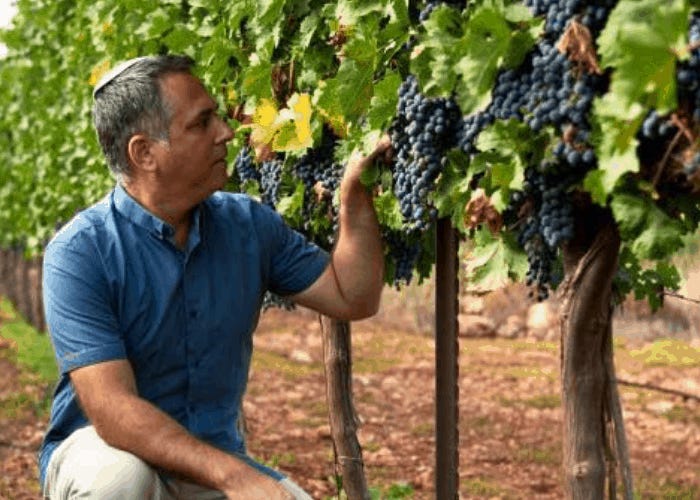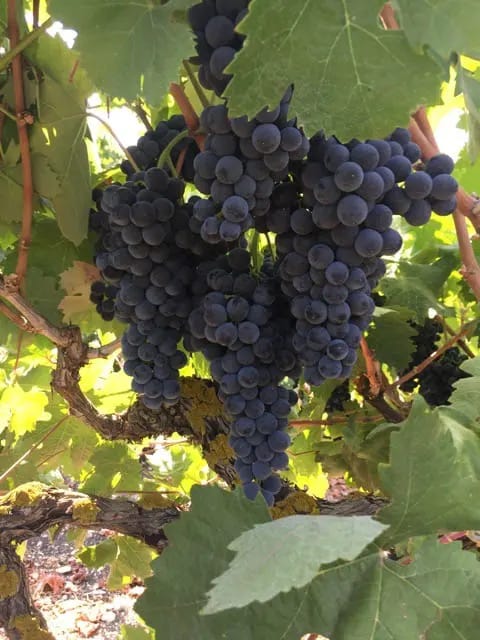A brief note on native Israeli wine grapes...
NOTE:
Finally finding some time to post a few of my articles here. First up is this piece I wrote sometime ago for the good folks at KosherWine.com. If memory serves, it appeared in their print newsletter which gets distributed to customers — but is not otherwise online. I have very mildly fiddled with it here.

An interesting trend in Israeli wine over the past decade has been the search for, and release to market of, wines made from native or indigenous grape varieties. Consider, for example, such wines as the Jezreel Valley Single Vineyard Argaman, the Barkan Argaman wines, the Segal Native Marawi, or the Recanati Reserve Bittuni and Reserve Marawi.
These local variety driven wines are not only examples of Israeli innovation and the commercial desire to offer something new or different to increase brand awareness and, ultimately, push higher sales, but are also expressions of a very real yearning for authenticity and identity.
“In the Israeli wine industry,” Yehuda Nahar, CEO and co-founder of the Jezreel Valley Winery, once explained it, “we are all more and more understanding that we… need to find the answer to ‘what is Israeli wine?’ Some wineries, like us at Jezreel are approaching this through our focus on varietal selection, locally appropriate varietals that make wines that are more fresh and easy drinking, wines that fit our hot, Mediterranean climate.”
“Israeli wine is not really defined yet,” as Gil Shatsberg, the Recanati Winery’s [then] Executive VP and head winemaker put it to me a few years back. Rather, he explained, Israeli wine “is like a fusion [stylistically] from all over the world,” especially since so many of Israel’s winemakers train in Europe, America, and Australia (Shatsberg himself trained at UCDavis in California [my own undergraduate alma mater]).
The world over, many winemakers—especially smaller, artisanal producers—produce wines that others recognize and laud as an authentic representation of the winemaking traditions and local geographic regions from which these wines emerge. Many other winemakers aim to produce wines that might be so recognized and, hopefully also, prized for such localized attributes. In Israel, however, winemakers have no solid history or significant winemaking traditions of any great age from which to draw-upon for inspiration, much less guidance.
For unlike in such countries as France or Italy, where wine traditions are purportedly rooted in a rich winemaking history stretching back through centuries of near constant, uninterrupted production from vintage to vintage, the Israeli wine industry is still in its relative infancy. Owing to centuries of Muslim occupation under the Ottoman Empire starting in the early 16th century, Israel’s wine traditions—whatever they might have been—were effectively lost. The sands of time swept through, and the desert encroached and overwhelmed as foreign rulers came and went. The historic record of wine production in what is today the modern State of Israel is surmised only through archeology.
When the commercial wine industry was restarted in the very late 19th century, it began with a clean slate. Thus, the Israeli wine industry began by producing European or international styled wines from European-origin grape varieties. Over the last decade, however, there has been significant interest in finding more native, more indigenous, more “authentic” Israeli grape varieties.
In terms of the historic legacy varieties, as Israeli wine writer and industry insider Adam Montefiore recently put it, “a decade ago, we knew there were local grape varieties, grown for centuries in the vineyards of the Holy Land, but we never thought of them as being wine grapes” even though "the wineries that were founded by Jewish families like Shor and Teperberg in the 19th century” used these same grape varieties, “purchased from Arab-owned vineyards mainly in the Hebron area”, such as Bittuni and Baladi for red wine, and Dabouki, Marawi (known as Hamdani around Bethlehem and Jerusalem), Jandali, and Zeini for white wine. As Montefiore put it, these "varieties survived the Ottoman Empire because they were sweet and tasty” so they “were used as table grapes, to make raisins” and the like. “Local Jews and Christians,” notes Montefiore, “always made wine, but it was a domestic affair, not an industry.”
Since these grapes varieties were cultivated in the pre-modern, pre-industrial planning era, the vineyards were often a haphazard affair, offering a higgledy-piggledy field blend of whatever happened to survive and thrive. Vineyard identification, such as it was, was not much concerned with variety type. Indeed, it is only in the last decade or so that such grape verities have undergone serious study with an eye towards advancing Israeli viticulture.
In 2011, Dr. Elyashiv “Shivi” Drori and a team of researchers funded in large part by a grant from the Jewish National Fund began groundbreaking research at Ariel University in search of the native grapes of Israel. Drori is also the winemaker at the Gva’ot Winery, which produces typically wonderful commercial quality wines, so the industry has been carefully following his research. Using cuttings collected from wild grapevines found all over Israel, carefully comparing their DNA to the large grape DNA database at the University of Milan, Drori and his team have discovered 120 unique varietals, some 12-20 of which are potentially suitable for making wine. Drori is actively cultivating these varieties to test-drive them, producing experimental wines at a micro-winery through Ariel University.
In 2014, the Recanati Winery partnered with Drori to start producing wine from the Marawi grape. The grape was sourced from a Palestinian Arab owned vineyard near Bethlehem where it is cultivated as a table-grape rather than a wine-grape. These are 30-year-old, dry-farmed vines grown at an altitude of 2,600 feet above sea level. The vines are pergola-trained in the traditional trellising method known as the “Hebron Overhead Arbor,” which protects the grapes from direct sunlight. Shatsberg said he and the Recanati folks tasted several small-scale experimental wines from Drori’s research team and Marawi really “stood out as worthy for commercial production.”
The vineyard’s owner remains anonymous, as does the name of his vineyard, out of fear of boycott or reprisal for working with the Israelis. Since the vineyard was planted far too densely for tractors Recanati’s team harvested the vineyard using donkeys.
Recanati produced just 2,480 bottles of this first vintage, but the release attracted significant international attention as it was thought to be the sort of wine that King David or Jesus might have drunk. Shatsberg noted that the initial reaction was “really amazing” and that it seemed “as if the market was waiting for something unique and authentic.” The wine received positive reviews from critics, and has continued to do so with subsequent vintages (including a 90-point score from Robert Parker for the ‘16 vintage).
Working with the same Palestinian farmer, Recanati started in 2016 to produce a red wine made from the native Bittuni grape. That same year, two other kosher Israeli wineries—Drori’s Gvaot Winery and Nahar’s Jezreel Valley Winery—also started to produce wine made from native grapes. Before too long, the Barkan Winery began doing so as well.
Another interesting development, particularly in terms of an authentic grape variety, is the seriousness with which Israeli winemakers increasingly approach the Argaman grape.
Arguably the most authentic Israeli red wine variety, Argaman was created in 1972 by the Israeli agronomist Professor Roy Spiegel at the Volcani Institute of Agriculture, in collaboration with Dr. Shlomo Cohen of the Israeli Wine Institute.
The result of careful crossbreeding between the Carignan grape with the Portuguese grape variety Sousão, Argaman, which means “deep purple” or crimson in Aramaic, was created to improve color in less sophisticated red Israeli wines. The resulting wine was indeed good for color, but little else. Still, Argaman was subject to wide experimentation in the 1980s and was eventually planted commercially in the 1990s.
Winemaker Avi Feldstein, then of Segal Wines, became convinced that Argaman had greater potential if cultivated more seriously, and in better locations. In 1999 Feldstein began planting Argaman in the Upper Galilee at the Dovev vineyard, over 700 meters above sea level.
Using precise pruning, careful canopy management, and dramatically improved site-selection, Feldstein reduced yields substantially, and came up with much higher quality fruit. The grapes were still lacking in natural tannins, so Feldstein fermented the Argaman on Merlot skins. The resulting wines were wonderful and very well received—deep colored, rich with plummy red berry fruits and very decent balance—even winning international wine competitions. Other winemakers took note and followed suit.
It remains uncertain whether the pursuit of these sorts of indigenous grape varieties will bring Israeli winemakers any closer to discovering a sense of wine identity. Thus far, for example, the commercially released wines made from the various “ancient” grape varieties have been a critical success, but they are not—and cannot be—expected to overtake or crowd out more familiar, mainstream grape varieties.
“Look,” as Jezreel’s Nahar once explained, “it is very difficult as it is to sell Mediterranean varietal wines in New York, London, or Paris. It would be like a hundred times more difficult with ancient varietals nobody has ever heard of, with flavors that are not familiar to anybody.”
Similarly, Gil Shatsberg, [then] head winemaker of the Recanati Winery, also agrees that these ancient varieties are more about philosophic Israeli identity than pure commerce. He noted, for example, that the Recanati winery’s efforts with the “Marawi [grape] are not ever going to replace Chardonnay or Sauvignon Blanc, but it is something unique that Israel can produce, something to be proud of, and that Israel can show for its heritage, and which is naturally adapted to its climate and soil.”
Flavor-wise, the Bittuni grape tends to produce a relatively light, fruity and spicy red wine that tastes something like a cross between Grenache and Pinot Noir, almost Gamay-like. While the Marawi tends to produce white wines that are slightly savory and saline, even a little fat, but still reasonably fresh and engaging with delicate peach or apricot aromas, and a little melon and citrus on the palate.
While Argaman tends to produce wines with cherry fruit notes, good acidity, and a slightly peppery quality, with the style of the wine ranging from light and fruity—best served slightly chilled—to plush, deep-bodied, oak aged wines that are a bit more character-driven.
Exploring such wines may not fully answer the riddle of Israeli wine identity, but the journey is likely to be educational, rewarding, and deeply satisfying.
L’chaim!
About me:
By way of background, I have been drinking, writing, consulting, and speaking professionally about kosher wines and spirits for more than 20 years. For over a dozen years I wrote a weekly column on kosher wines and spirits that appeared in several Jewish publications, and my writing generally has appeared in a wide variety of both Jewish and non-Jewish print and online media. A frequent public speaker, I regularly lead tutored tastings and conduct wine and spirits education and appreciation programs. Those interested in contacting me for articles or events can do so at jlondon75@gmail.com.
In what seems like a lifetime ago, I also wrote an entirely unrelated slice of American history: Victory in Tripoli: How America’s War with the Barbary Pirates Established the U.S. Navy and Shaped a Nation (John Wiley & Sons, 2005).
These days I live in London (UK) and, when not focused on wine and spirits, serve as the CEO of the Anglo-Israel Association which is focused on advancing the UK-Israel relationship, and promoting education about Israel.



